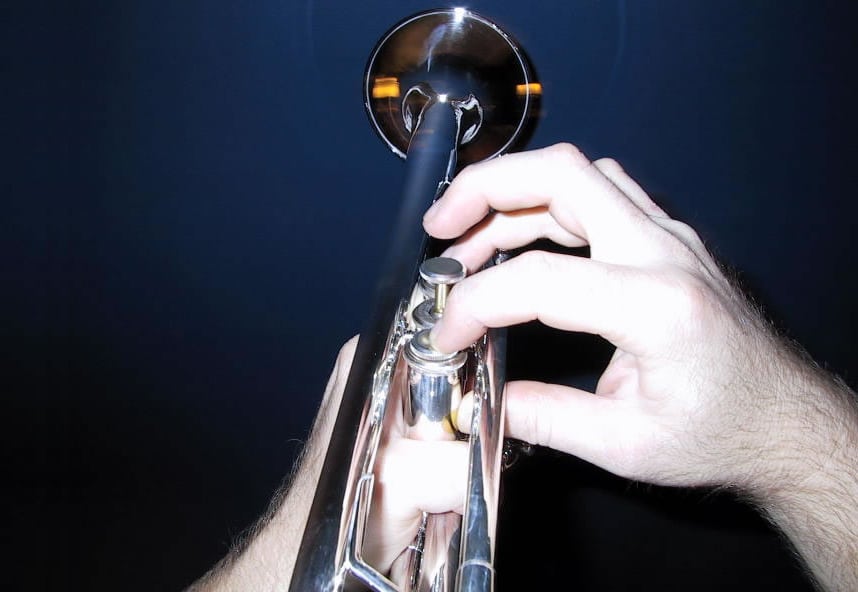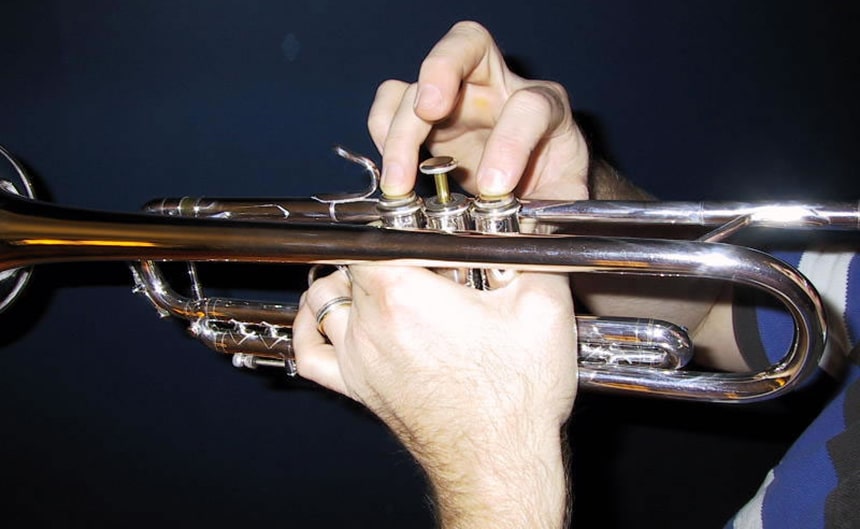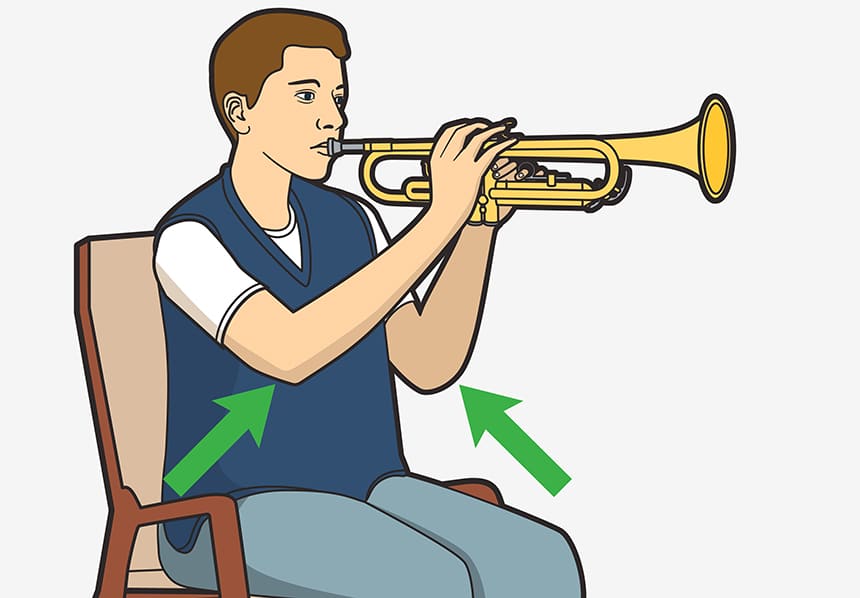The trumpet is such a fun and impressive instrument, with a bright and loud sound that makes people take notice. More and more people are learning even brass instruments at home, which means that they need tips on things like how to hold a trumpet. If you’ve decided to go the route of starting out without the help of a teacher or using online lessons then this is one of the vital things to get right, it’s also a fundamental piece of knowledge when you are starting out in the world of playing the trumpet. It’s one of the very first things that you need to make sure you have nailed before moving onto other techniques. In this guide, we’re showing you the standard grip and some other useful tips and information that should help you when it comes to early steps of holding and playing your trumpet.
A lot of people don’t realize that there is a standard grip for this, and other brass instruments. The temptation is just to pick it up and grab it in a way that feels right to you. This is something that a lot of people do for months, or even years, especially if they aren’t working directly with a teacher. This embeds bad habits into your playing.
Even though there are examples of trumpeters playing with other grips, that shouldn’t be your starting point. Once you have learned the standard grip, you might be able to slightly vary your playing. Although there are different types of trumpet, unless you have something very unique then this is the technique you should use to hold your instrument, at least to start with.

We’re focusing on a standard-designed trumpet here. If you are playing something a little bit out there or different such as a pocket trumpet then the advice may well be different.
The way you position your right hand is all about providing stability for the instrument. There are some unique ways in which people teach this right hand placement for trumpets. Firstly, you need to take your thumb and place it between the first valve and the second. This is the correct way to do things. While it is tempting to just put the thumb in front of the very first valve, you’ll find after some time that this can put a strain on your hand and even cause you pain.
Your three middle fingers then all sit nicely above the valve caps. This is a way to ensure that you have a great level of control and you can easily flex and interact with the valves to produce the tones you want to. Don’t use the very tips of your fingers as this can make your hands hurt once more, and can even make you cramp up as a result. Instead, touch the valve caps with your finger pads, giving a larger surface area.
If your fingers go too far and sit past the valve itself, you will lose a level of control. There’s an art to your finger position!
Don’t put your pinky finger in the ring. While this is something that some trumpet players do, it’s not advised, it can make it harder to play with more tension needed from the face, which can lead to some really sloppy trumpet playing. The pinky should be relaxed.

The left hand is a little bit simpler to understand. It’s all about stability, and your left hand is the one that will give you the firm grip on your trumpet. Now, this sounds incredibly easy, but there is quite a lot to consider here.
You shouldn’t be tightly gripping the instrument, instead, just holding it steady. You need to try and have a relaxed hold. Think of it light holding a baby animal, you need to firmly keep it held upright, but you don’t want to grip or squeeze. Relaxed!
In terms of finger position, the best hold possible is achieved if your thumb is on the first valve and the index finger is near the third. This isn’t as essential as some of the right hand techniques, and you can vary things slightly, but it does give you the best chance of avoiding dropping your instrument.
You’ll then have unused fingers, which can go in the ring of the first slide. This means that you control the third slide while you’re playing. The fourth finger is commonly the one used for this, but it is one of the things that is up to you. It depends on what you find most comfortable.

A lot of people who are reading this guide will have just bought a trumpet for beginners, such as a Jean Paul model, and they’ll want to know how to grip it before going through some of their lessons.
Learning online, it’s even more vital to get right as there won’t be anyone to correct you. One of the key things that you need to master is the posture, and of course, the technique to actually play your instrument.
Posture is absolutely vital. If you slouch, you aren’t going to be able to get enough air in your lungs, and it is going to make your airflow irregular and the volume unsteady. It doesn’t matter if you sit or if you stand, but you need to make sure you are straight, in an upright position with a strong and straight back. Imagine the way your teacher would have told you to sit at school!
A lot of people find it much easier to get to this level and use their lung capacity when they are 100% upright, which means standing, but it is good to practice in both scenarios. You can’t always guarantee you are going to be in a position to stand to practice and perform.
Next, you need to relax, particularly around your shoulders. Relaxed shoulders do a couple of things for trumpeters. This isn’t some zen recommendation, it actually helps to stop pain in the neck, which can occur if you’re playing for a long time. It also aids the body in taking deep and steady breaths, essential for proper playing.
Though this is the main aspect of posture when it comes to the trumpet, there are some other considerations. These absolute basics are important for making sure that you don’t have poor technique and develop bad habits that can be stuck with you for years.
It’s really easy to keep over-analyzing all of these techniques, we know. Try not to do this as it can lead to you doing what is very uncomfortable rather than relaxing, which is exactly what you should try and do when you are holding a trumpet.
So, what about left-handed players? Is there such thing as a left-handed trumpet, like there are left-handed guitars? The answer is “no”. Even as a newcomer, you’re on the same beginner trumpets as the rest of us!
This might sound a bit like a disadvantage for those who are playing with their left hand as the dominant hand, but it is not at all. The trumpet isn’t really an instrument where it matters which is your dominant hand. There are pros and cons to it for a leftie.
Actually, holding and pressing the keys is not really any trickier if your left hand is dominant. The right hand usually has to play some of the more technical methods and techniques of playing the trumpet, but a little bit of practice is normally enough to get virtually anyone up to standard here. Even if your left hand is stronger, your right will be able to do everything required.
Some people find it easier because of the strength they have in their left hand. It might be simpler to support the weight of the trumpet or play for a long time, plus you won’t have to spend as long practicing your grip. Longer sessions may be easier for lefties.
Left-handed trumpeters sometimes struggle with their left palm, which might naturally rest against the casing of the valves and make it harder to use the slides. This can be a tricky thing to navigate, but like we said, there are pros and cons.
The truth is that both left and right-handed players will need to take some time to get used to the techniques needed to play the trumpet. This really isn’t an overnight thing. Fortunately, lefties are at no real disadvantage, so you don’t have to buy any special equipment, you just have to get used to it and put in the hours. This is the advice that not every aspiring musician wants to hear, but it is true whether you are left or right-handed.
Nobody can tell you that this is the most exciting aspect of playing the trumpet. Holding the instrument correctly is just one of the very fundamentals that you have to get right. It might be tempting to just think that you can master this at a later date, or when you move on to a better trumpet, but this is not the case. Just like learning to ride a bike, if you develop bad habits early on, they are likely to cause problems for years to come.
Our guide on how to hold a trumpet should make it much easier for you to get the correct level of airflow and to play consistently. These fundamentals might feel like they are just boring hoops you have to jump through, but getting the correct hold and posture will improve your playing hugely. While not the most enjoyable lesson, it is a good idea to practice and get to a point where the right posture and holding the trumpet feels natural.